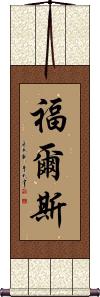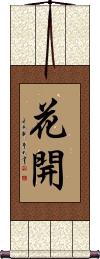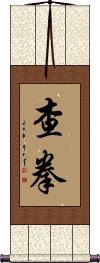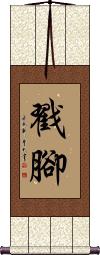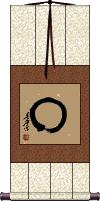Many custom options...
And formats...

Falls in Chinese / Japanese...
Buy a Falls calligraphy wall scroll here!
Personalize your custom “Falls” project by clicking the button next to your favorite “Falls” title below...
Falls
Falls
Flower Open / Blooming Flower
These two characters mean “flower open.”
花開 is also associated with Springtime, the beginning of something, or youth.
花開 is often followed by 花落 or “flower falls” (closes and loses its petals) which means “Things come and go” or “Youth comes and goes.”
If you like flowers and Springtime, this is a great selection for you. However, if you want the companion “flower falls” (flower withers), we offer that as a companion wall scroll or all together as a four-character phrase.
See Also: Flowers Fall
Chaquan / Cha Quan
查拳 is the title for the Chaquan, Chāquán, or Cha Quan style of Chinese martial arts.
The meaning is “Inquisitive Fist,” and it falls under the category of the Northern Schools.
Cha Quan features graceful movements and acrobatic stunts (often flying through the air). Many different forms of weapons are used in Cha Quan.
Choujiao / Chou Jiao
戳腳 is the title for Choujiao, Chuōjiǎo, or Chou Jiao.
This means poking or stabbing foot. This is a Chinese martial art that falls under the Northern School.
There are many jumps, kicks, and lightning-fist actions in this style.
You'll find Chou Jiao practiced in Liaoning Province, Hebei Province, and Beijing.
Enso - Japanese Zen Circle
〇 is the famous Enso symbol, which you will see widely used by Japanese Zen Buddhists.
In a twist, I am starting to see Enso used more and more by Chinese Buddhists.

Here is the typical appearance of Enso artwork by Japanese calligrapher Kougetsu.
Enso is not a Japanese Kanji character. It falls more into the category of a symbol. There is some debate, but many consider Enso to be a religious symbol.
Some call this “The Circle of Enlightenment.” Others call it the “Infinity Circle.” If you actually took the meanings of the two Kanji (円相) that make up the word “En-so,” you could read it as “Mutual Circle” or “Circle of Togetherness.” I think the Enso symbol can simply mean different things to different people. Therefore, you should let it have the meaning that you perceive.
The appearance of your Enso will be determined by the artist's personal style, feeling, mood, etc.
Not the results for Falls that you were looking for?
Below are some entries from our dictionary that may match your Falls search...
| Characters If shown, 2nd row is Simp. Chinese |
Pronunciation Romanization |
Simple Dictionary Definition |
不動明王 不动明王 see styles |
bù dòng míng wáng bu4 dong4 ming2 wang2 pu tung ming wang fudoumyouou / fudomyoo ふどうみょうおう |
More info & calligraphy: Fudo Myo-o / Wisdom King不動尊 Aryacalanatha 阿奢羅曩 tr. 不動尊 and 無動尊 and Acalaceta, 阿奢囉逝吒 tr. 不動使者. The mouthpiece or messenger, e. g. the Mercury, of the Buddhas; and the chief of the five Ming Wang. He is regarded as the third person in the Vairocana trinity. He has a fierce mien overawing all evil spirits. He is said to have attained to Buddhahood, but also still to retain his position with Vairocana. He has many descriptive titles, e. g. 無量力神通無動者; 不動忿怒王, etc. Five different verbal signs are given to him. He carries a sharp wisdom-sword, a noose, a thunder-bolt. The colour of his images is various—black, blue, purple. He has a youthful appearance; his hair falls over his left shoulder; he stands or sits on a rock; left eye closed; mouth shut, teeth gripping upper lip, wrinkled forehead, seven locks of hair, full-bodied, A second representation is with four faces and four arms, angry mien, protruding teeth, with fames around him. A third with necklaces. A fourth, red, seated on a rock, fames, trident, etc. There are other forms. He has fourteen distinguishing symbols, and many dharanis associated with the realm of fire, of saving those in distress, and of wisdom. He has two messengers 二童子 Kimkara 矜羯羅 and Cetaka 制吒迦, and, including these, a group of eight messengers 八大童子 each with image, symbol, word-sign, etc. Cf. 不動佛. |
啄 see styles |
zhuó zhuo2 cho taku たく |
to peck (See 永字八法) seventh principle of the Eight Principles of Yong; stroke that falls leftwards with slight curve; (given name) Taku |
磔 see styles |
zhé zhe2 che taku たく |
old term for the right-falling stroke in Chinese characters (e.g. the last stroke of 大[da4]), now called 捺[na4]; sound made by birds (onom.); (literary) to dismember (form of punishment); to spread (See 永字八法) eighth principle of the Eight Principles of Yong; stroke that falls rightwards and fattens at the bottom |
傍晚 see styles |
bàng wǎn bang4 wan3 pang wan |
in the evening; when night falls; towards evening; at night fall; at dusk |
八墮 八堕 see styles |
bā duò ba1 duo4 pa to hachida |
idem 八波羅夷. |
冷宮 冷宫 see styles |
lěng gōng leng3 gong1 leng kung |
(in literature and opera) a place to which a monarch banishes a wife or concubine who falls from favor; (fig.) the doghouse; a state of disfavor |
四墮 四堕 see styles |
sì duò si4 duo4 ssu to shida |
(四墮落法) The four causes of falling from grace and final excommunication of a monk or nun; adultery, stealing, killing, falsity; v. 四波羅夷. |
墮惡 堕恶 see styles |
duò è duo4 e4 to o da aku |
falls into evil |
山雪 see styles |
sansetsu さんせつ |
(See 里雪) snow that falls on mountains; (given name) Sansetsu |
振休 see styles |
furikyuu / furikyu ふりきゅう |
(abbreviation) (See 振替休日・ふりかえきゅうじつ・1) substitute national holiday; day off in lieu of a national holiday that falls on a Sunday; compensatory holiday |
春社 see styles |
shunsha しゅんしゃ |
(See 社日,戊・つちのえ) spring "tsuchinoe" day that falls closest to the vernal equinox (a day of religious significance for harvests) |
水落 see styles |
mira みら |
(1) (kana only) pit of the stomach; solar plexus; (2) place where water falls; (surname) Mira |
社日 see styles |
shanichi しゃにち |
(See 戊) "tsuchinoe" day that falls closest to the vernal or autumnal equinox (a day of religious significance for harvests); (place-name) Shanichi |
里雪 see styles |
satoyuki さとゆき |
(See 山雪) snow that falls on villages |
閉幕 闭幕 see styles |
bì mù bi4 mu4 pi mu heimaku / hemaku へいまく |
the curtain falls; lower the curtain; to come to an end (of a meeting) (n,vs,vi) (1) (ant: 開幕・1) falling of the curtain; (n,vs,vi) (2) (ant: 開幕・2) (coming to an) end; close |
雙節 双节 see styles |
shuāng jié shuang1 jie2 shuang chieh |
combined Mid-Autumn Festival and National Day (occurring when the Mid-Autumn Festival 中秋節|中秋节[Zhong1 qiu1 jie2] falls on October 1st, as in 1982, 2001 and 2020); binodal; two-section |
一の滝 see styles |
ichinotaki いちのたき |
(personal name) Ichi Falls |
催花雨 see styles |
saikau さいかう |
spring rain that falls around the time that flowers bloom; spring rain that hastens the blooming of flowers |
墮惡趣 堕恶趣 see styles |
duò è qù duo4 e4 qu4 to o ch`ü to o chü da akushu |
falls into negative rebirths |
寝しな see styles |
neshina ねしな |
(usu. as ~に) just before going to bed; just as one gets into bed; just as one falls asleep |
岩の滝 see styles |
iwanotaki いわのたき |
(place-name) Iwa Falls |
崩の滝 see styles |
kuzurenotaki くずれのたき |
(personal name) Kuzure Falls |
幣の滝 see styles |
nusanotaki ぬさのたき |
(place-name) Nusa Falls |
桂の滝 see styles |
katsuranotaki かつらのたき |
(place-name) Katsura Falls |
水落ち see styles |
mizuochi みずおち |
place where water falls |
洛皮塔 see styles |
luò pí tǎ luo4 pi2 ta3 lo p`i t`a lo pi ta |
Lawpita Falls on the Balu Chaung river, location of Myanmar's biggest hydroelectric plant |
緋の滝 see styles |
hinotaki ひのたき |
(place-name) Hi Falls |
聖の滝 see styles |
hijirinotaki ひじりのたき |
(place-name) Hijiri Falls |
華厳滝 see styles |
kegonnotaki けごんのたき |
(place-name) Kegon Falls (near Nikko) |
華巌滝 see styles |
kegonnotaki けごんのたき |
(place-name) Kegon Falls (near Nikko) |
Click here for more Falls results from our dictionary
The following table may be helpful for those studying Chinese or Japanese...
| Title | Characters | Romaji (Romanized Japanese) | Various forms of Romanized Chinese | |
| Falls | 福爾斯 福尔斯 | fú ěr sī fu2 er3 si1 fu er si fuersi | fu erh ssu fuerhssu |
|
| Falls | フォールズ | fouruzu / foruzu | ||
| Flower Open Blooming Flower | 花開 花开 | huā kāi / hua1 kai1 / hua kai / huakai | hua k`ai / huakai / hua kai | |
| Chaquan Cha Quan | 查拳 | chá quán / cha2 quan2 / cha quan / chaquan | ch`a ch`üan / chachüan / cha chüan | |
| Choujiao Chou Jiao | 戳腳 戳脚 | chuō jiǎo chuo1 jiao3 chuo jiao chuojiao | ch`o chiao chochiao cho chiao |
|
| Enso - Japanese Zen Circle | 〇 | en sou / ensou / en so | ||
| In some entries above you will see that characters have different versions above and below a line. In these cases, the characters above the line are Traditional Chinese, while the ones below are Simplified Chinese. | ||||
Successful Chinese Character and Japanese Kanji calligraphy searches within the last few hours...
